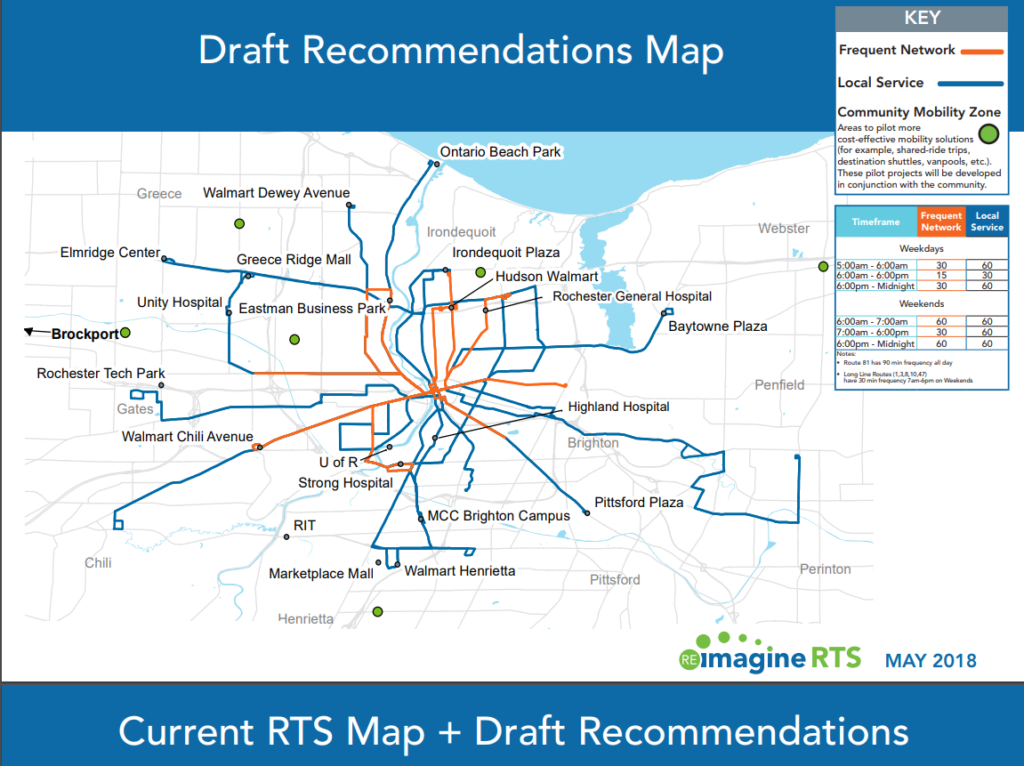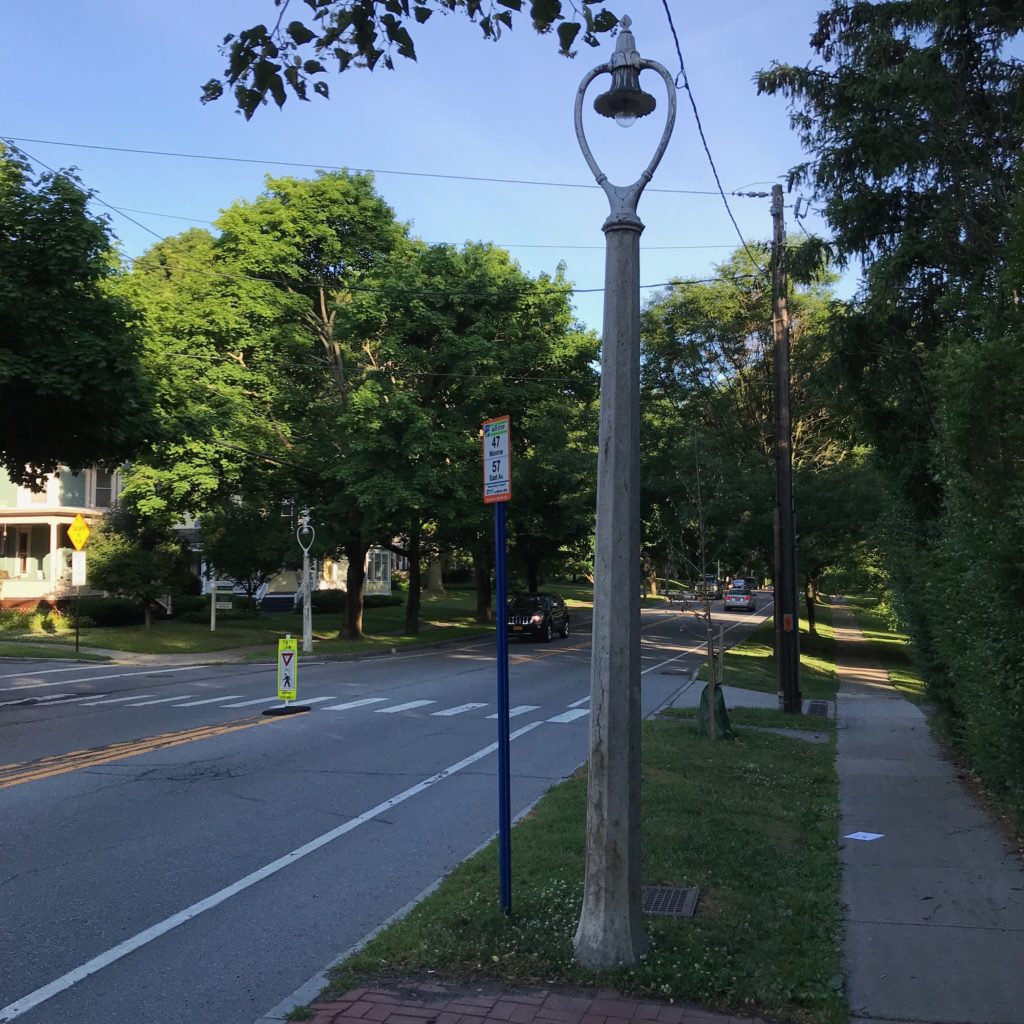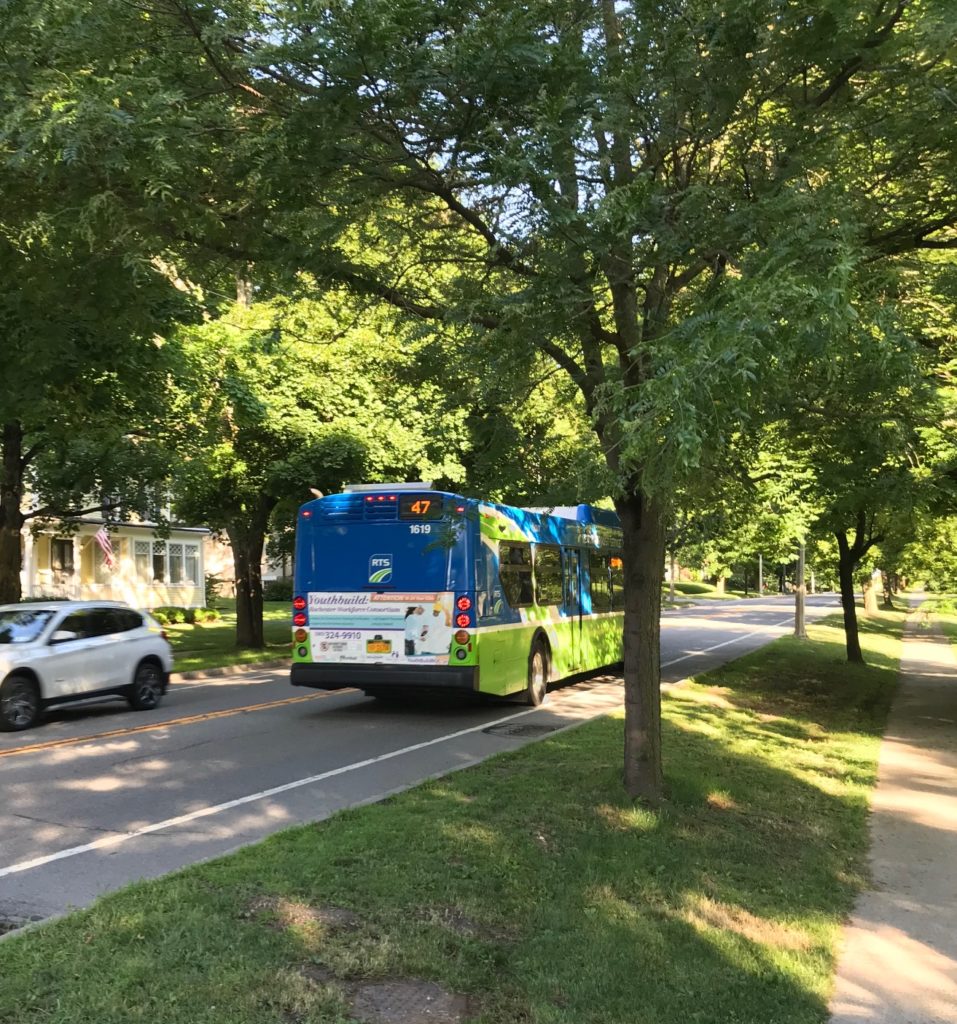See Dec 2018 update from community stakeholder meeting here.
RTS is redesigning its system. It recently released its Reimagine RTS draft recommendations. And it’s not looking good for Pittsford. Route #47 will end at Pittsford Plaza. It currently runs to the Village and turns around at the Pittsford Loop (the big turnaround just south of the Village line on S. Main. St.) And there are no longer buses to Nazareth and St. John Fisher, which is currently Route #57. There isn’t anything near the new YMCA.
You’ll notice one more troubling thing — Pittsford isn’t even given a green dot for “Community Mobility Zone,” which will give access via a different vehicle/option other than the big huge traditional bus.
Most people in Pittsford don’t ride the bus. That’s due to all sorts of reasons:- most can afford to and are able to drive
- the built environment outside the village prioritizes (and, in many places, necessitates) car travel
- there isn’t convenient & frequent bus service that extends beyond the village or the colleges (and even the routes to the village have been cut drastically over the years)
- misconceptions/biases about traveling by bus
- it’s so damn easy and fast to travel by car in Rochester
Here’s Why You Should Care About Having Bus Access:
1.) We Want a Community That Is Accessible To All:
Losing the #47 beyond Pittsford Plaza means there will be no mass transit access to the Village or to the courts & employee complex at 3750 Monroe Ave along the way. We are one of the most walkable communities in Rochester and we will be cut off from the rest of the region, except to those who are privileged enough, old enough and able-bodied enough to have access to a car. Sure, you can still bike here (if you are brave and able enough). Forget getting to and from your job in the village. Forget aging in place. Forget being an independent teenager that wants to head to an evening movie. And forget being an Urban Suburban Program student at Sutherland High School.
2.) Our Active Transportation Plan Includes the Need for Mass Transit
The Town and Village have been working diligently on an Active Transportation Plan. Active transportation is human powered forms of transportation — biking, walking, rolling, riding the bus then walking to your destination.
3.) We Can’t Have a Walkable Community Without Mass Transit
Walkability in the village and surrounding areas has been identified as a major priority by the community. A neighborhood is walkable if you can take care of your daily amenities without the use of a car (which means things to walk/bike to and the infrastructure to safely get you there.)
But …Traffic traffic traffic. It’s the topic of conversation at every public input session, every hearing for a new project, every Village Speaker Series and education session. The public is crying for a better and safer pedestrian and biking experience. People are afraid to let their kids bike to school for fear of speedy, aggressive drivers.
Want to ease that traffic congestion? Give people options for travel. Want to have a village that progresses, grows and isn’t swallowed up by car traffic? Without bus access, future development has to rely solely on car transportation, which will only increase traffic concerns and decrease accessibility for many.
4.) Once The Bus Route to the Village Is Gone, It’s Very Difficult to Get It Back
Due to ridership, the village lost many stops in previous RTS redesigns. And this will be a slide backwards for our community’s walkability, equity, and accessibility.
Why Does the Draft Plan Eliminate The Village, Nazareth and SJF Stops?
Ridership. This redesign is focused on the users who ride the bus most frequently and, often, don’t have another option. The current system is not serving them well.
31% of bus commuters in Rochester spend an hour or more commuting ONE WAY. Not because we live in a huge metropolis. But because the current system is stretched thin and those who need it most in the core areas are losing out.
My family uses the #47 and #57. In fact, that went into our decision when we bought our house. Having the bus stop less than a block away was a huge plus. We know ridership is low; we see the empty buses pass our house. We often join only 1 or 2 others on the #47. When we hop on the #57 at Nazareth, there are a few more — thanks to the college — but it’s still light.
But we, like many in Pittsford, have a choice. If the bus goes away, we still own a car. We can still get to our jobs, get groceries and get our family to doctor and dentist appointments.
If you never take the bus, take a peek at Reconnect Rochester’s Street Films discussion with 3 people who have to rely only on the bus.
What’s the Next Step for RTS?
RTS will be conducting the Mobility Management Study, which will look at the Community Mobility Zones and other recommendations from various stake holders.
[Take a look at Reconnect Rochester’s summary of the draft and what it does and doesn’t like.]
The Town of Pittsford is currently finishing up its comments and will have them to RTS on Friday.
What Can You Do to Help Assure There Is Mass Transit Access in the Village?
Submit Your Feedback to RTS right now.
- Take their quick online survey (it takes less than a minute).
- Or send your thoughts directly to RTS: at 585-288-1700 or myRTS.com/Contact-Us
Update After August 21st Board Meeting (courtesy of Town Board Member, Stephanie Townsend):
“* The proposed changes to the fixed routes will eliminate most of the current fixed-schedule bus service in Pittsford, an exception being continued service from downtown to Pittsford Plaza.
* However, “Community Mobility Zones” are being formed to serve suburban areas. In the May 2018 Reimagine RTS report, Pittsford was not included in a CMZ. However, as a result of advocacy from the Town Board, Pittsford is now part of a Southeast CMZ.
* For a description of CMZs, see pages 55-56 of the Reimagine RTS Report. They include options such as shared rides, destination shuttles, vanpools, car sharing, and connection hubs. However, the plans for CMZs are only in the initial stages so there are no details yet about what the Southeast CMZ might look like.
* The new RTS system will be launched in 2020. That will include launching the new fixed route system and the CMZs at the same time, so there should be no gap in service.”



